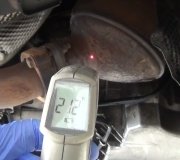Left car in parking lot overnight. Had car towed home next night. Still runs like crud. I cut the exhaust pipe behind cat converter. Took exhaust pipe off at exhaust manifold. I can see the back end of cat conv looks fine. A light brown color. Can see into the honeycomb of cat conv. The front of cat conv was black. Looked like it was clogged up. I knocked out cat conv insides. (I was not going to buy a new cat until I know the cat is the problem.) I put back on and still runs like crud. Won't idle good. Have to rev to keep running. Power loss light keeps going on and off as your reving it. What could be the problem? Was somthing else damaged when all four cylinders were not firing?
Monday, May 23rd, 2011 AT 12:53 AM


